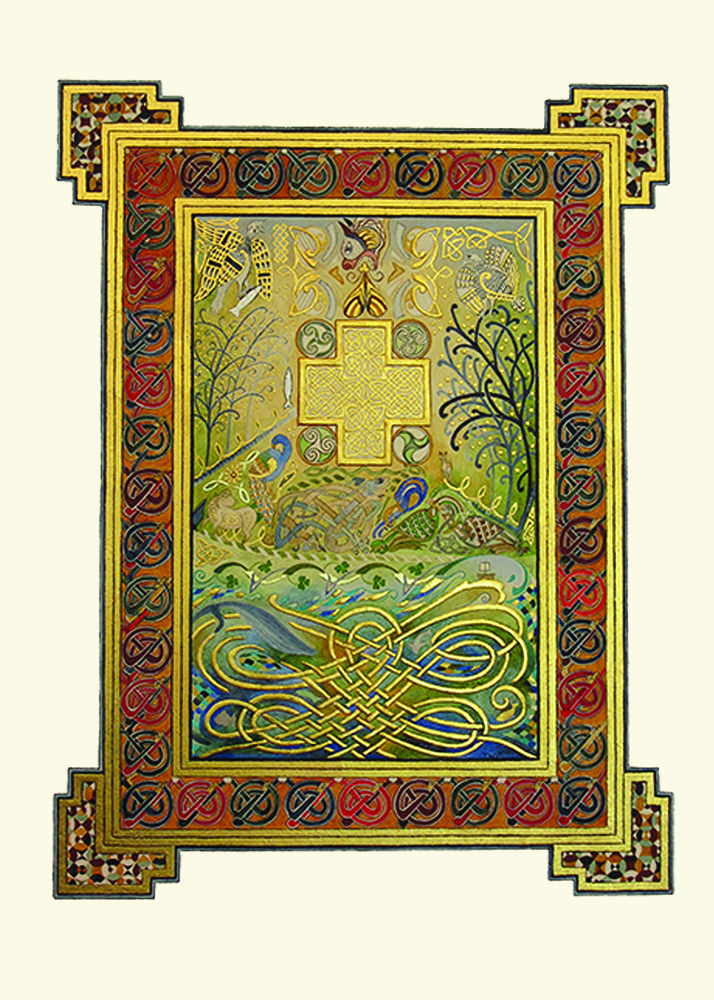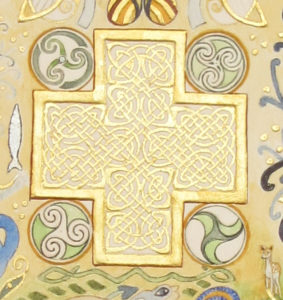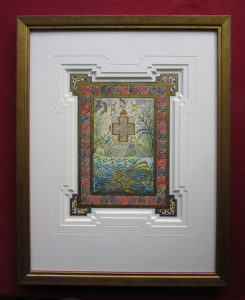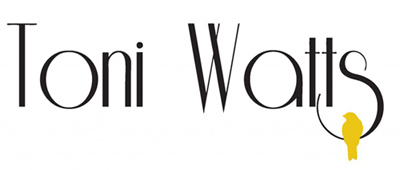Last March I was honoured to take part in the Home of St Patrick Festival in Northern Ireland. Events were held in three cities – Armagh, Downpatrick and Newry. During my time there I did gilding demonstrations in four beautiful cathedrals and began work on an illuminated page depicting the life of the saint.
It’s been a labour of love, but it is finally finished.
The idea for this piece of work came from a chance encounter with the work of Art O’Murnaghan (1872 – 1954) in a dusty tome in a secondhand bookshop in York. He combined traditional celtic art with modern narrative, inspired by the Easter Rising and the subsequent fight for independence.
St Patrick uses different imagery in a different way but shares the idea of marrying old artistic styles with new ideas. It also combines medieval techniques (24 carat gold on manuscript gesso made to a fifteenth century recipe) with modern paint formulations.

The Life of St Patrick, Toni Watts, 26.5 x 20cm, 24 carat gold, white gold, palladium and watercolour on paper.
The illumination is designed to be read from bottom to top, like a stained glass window. Each part of the image either tells something about the life of St Patrick, relates to items associated with the saint or is inspired by celtic designs as seen, for example, in the Book of Kells. Here are the details:
The ‘waves’ of the sea are inspired by the pattern on the side of St Patrick’s bell reliquary, with a small boat representing his capture by pirates. Landfall in Ireland is represented by shamrocks which were, of course, also used to teach about the Trinity. St Patrick stayed in woods and on mountains (the mountains in the illumination are made of knotwork animals and birds, with a top line representing the Mountains of Mourne). On the left is a sheep (for the livestock St Patrick is said to have cared for) and on the left a deer to represent the hymn ‘The Deer’s Cry’.

The central cross is for christianity with the fish (left of the cross) being a symbol of Christ and the peacock (below the cross, left), symbolising the resurrection. The two birds, top left and top right of the illumination, come from the Book of Armagh and Book of Kells, with the small piece of gilded knotwork next to the bird on the left being taken from the leather satchel of Armagh. The harps represent Ireland. The central creature is a lion, taken from the Book of Kells. The lion was also used as a symbol of Christ, representing the house of Judah. It has characteristically fierce features, but life-giving breath comes from its mouth. The border is adapted from that on f.32v in the Book of Kells.
It’s been beautifully mounted and framed by Mal Reynolds of Harlequin Frames.

I’m delighted that the piece is going ‘home’ to Armagh – the place where work began on it and somewhere that has immense significance in the life of St Patrick.

Stunning work. You are in a league of your own Toni.
Best wishes,
Vanda x